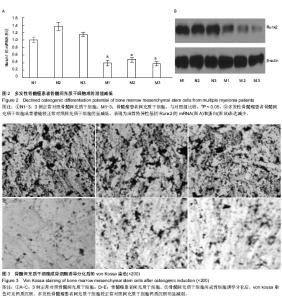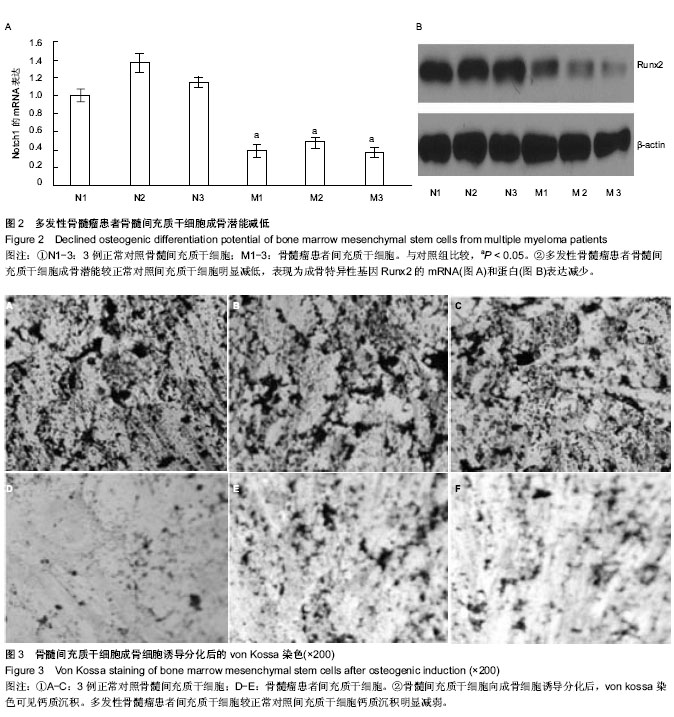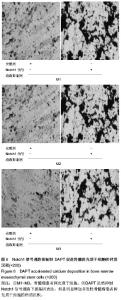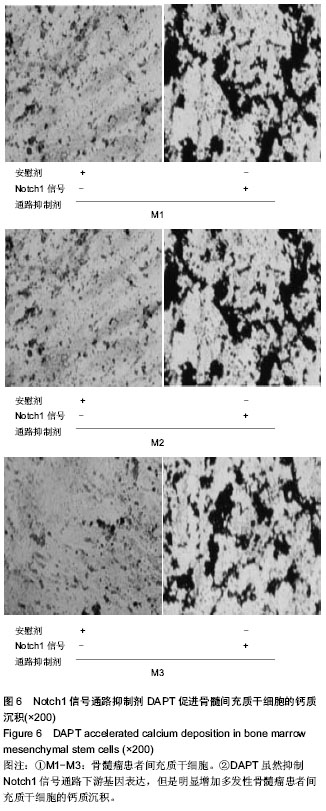Chinese Journal of Tissue Engineering Research ›› 2014, Vol. 18 ›› Issue (14): 2133-2139.doi: 10.3969/j.issn.2095-4344.2014.14.001
Effect of Notch1 signaling abnormality on the pathogenesis of myeloma bone disease
Zhu Hong-yan1, Wang Qian2, Li Ya-li2, Ge Xue-ping2, Chen Ping2, Li Bing-zong2
- 1Oncology Department of MuDu Hospital, Suzhou 215101, Jiangsu Province, China; 2Department of Hematology, Second Affiliated Hospital of Soochow University, Suzhou 215004, Jiangsu Province, China
-
Received:2014-02-08Online:2014-04-02Published:2014-04-02 -
Contact:Li Bing-zong, M.D., Associate chief physician, Master’s supervisor, Department of Hematology, Second Affiliated Hospital of Soochow University, Suzhou 215004, Jiangsu Province, China -
About author:Zhu Hong-yan, Master, Oncology Department of MuDu Hospital, Suzhou 215101, Jiangsu Province, China -
Supported by:the National Natural Science Foundation of China, No. 81172256; the Applied Basic Research Project of Suzhou City, No. SYS201132; the Doctoral and Overseas Scholar Fund of the Second Affiliated Hospital of Soochow University, No. SDFEYBS1106
CLC Number:
Cite this article
Zhu Hong-yan, Wang Qian, Li Ya-li, Ge Xue-ping, Chen Ping, Li Bing-zong. Effect of Notch1 signaling abnormality on the pathogenesis of myeloma bone disease[J]. Chinese Journal of Tissue Engineering Research, 2014, 18(14): 2133-2139.
share this article
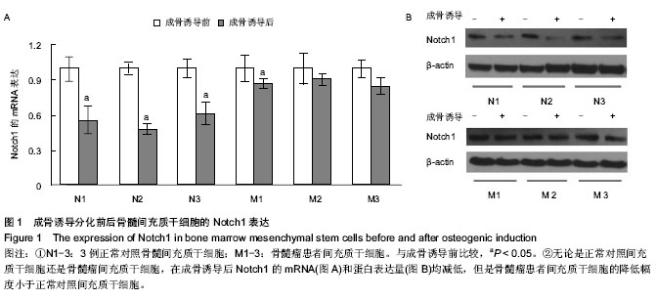
2.1 成骨诱导分化后Notch1表达 成骨诱导分化后间充质干细胞的Notch1表达降低,但是骨髓瘤患者间充质干细胞下降幅度小于正常对照间充质干细胞,分离和培养骨髓瘤患者间充质干细胞和正常对照骨髓间充质干细胞各3例,向成骨诱导分化48 h后Real-time PCR和Western blot检测Notch1的表达量,结果提示成骨诱导后Notch1的mRNA和蛋白表达量均减低,但是骨髓瘤患者间充质干细胞的降低幅度小于正常对照间充质干细胞(图1)。 2.2 骨髓瘤患者间充质干细胞的成骨分化潜能改变 成骨诱导分化48 h时后,Real-time PCR和Western blot检测成骨特异性指标Runx2的表达,骨髓瘤患者间充质干细胞的Runx2的mRNA和蛋白表达量均明显弱于正常对照间充"

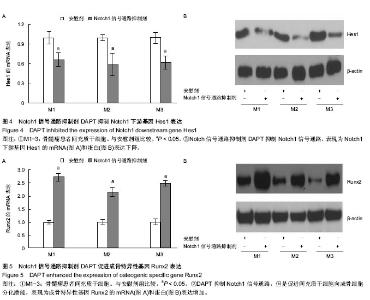
质干细胞(图2)。1周后,Von Kossa染色鉴定钙质沉积程度,骨髓瘤患者间充质干细胞明显弱于正常对照间充质干细胞(图3)。 2.3 Notch1信号通路抑制剂DAPT对Hes1表达的影响 在3个骨髓瘤患者间充质干细胞成骨诱导培养基中,加入Notch1信号通路抑制剂DAPT,48 h后Real-time PCR和Western blot检测Notch1下游分子Hes1表达,DAPT组Hes1的mRNA和蛋白表达量均明显低于安慰剂组(图4)。 2.4 Notch1通路抑制剂DAPT对间充质干细胞成骨细胞分化潜能的影响 48 h后Real-time PCR和Western blot检测Runx2的表达发现,DAPT组Runx2的表达明显高于安慰剂组(图5)。1周后Von Kossa染色鉴定钙质沉积程度,DAPT组钙质沉积明显强于安慰剂组(图6)。"
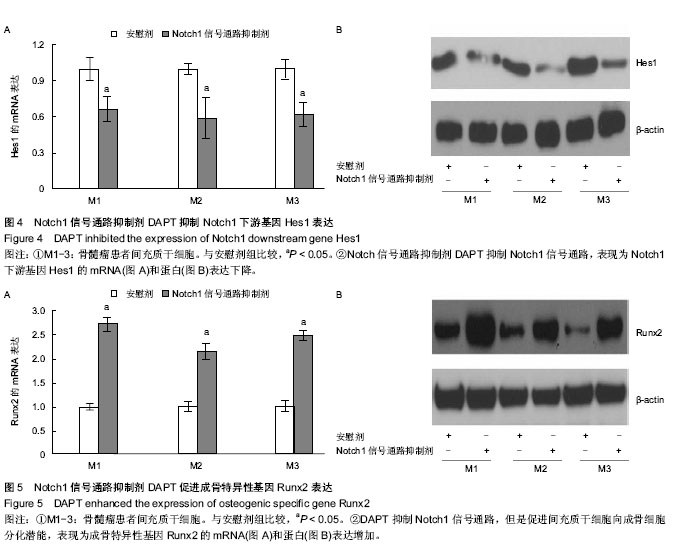
| [1] Alegre A, Gironella M, Bailén A, et al. Zoledronic acid in the management of bone disease as a consequence of multiple myeloma: a review. Eur J Haematol. 2013 Dec 14. [2] Giuliani N, Bataille R, Mancini C, et al. Myeloma cells induce imbalance in the osteoprotegerin/osteoprotegerin ligand system in the human bone marrow environment. Blood. 2001; 98(13):3527-3533. [3] Giuliani N, Morandi F, Tagliaferri S, et al. The proteasome inhibitor bortezomib affects osteoblast differentiation in vitro and in vivo in multiple myeloma patients. Blood. 2007;110(1): 334-338. [4] Horwitz EM, Le Blanc K, Dominici M, et al. Clarification of the nomenclature for MSC: The International Society for Cellular Therapy position statement. Cytotherapy. 2005;7(5):393-395. [5] Reagan MR, Ghobrial IM. Multiple myeloma mesenchymal stem cells: characterization, origin, and tumor-promoting effects. Clin Cancer Res. 2012;18(2):342-349. [6] Giuliani N, Mangoni M, Rizzoli V. Osteogenic differentiation of mesenchymal stem cells in multiple myeloma: identification of potential therapeutic targets. Exp Hematol. 2009;37(8):879-886. [7] Wharton KA, Yedvobnick B, Finnerty VG, et al. opa: a novel family of transcribed repeats shared by the Notch locus and other developmentally regulated loci in D. melanogaster. Cell. 1985;40(1):55-62. [8] Xu N, Liu H, Qu F, et al. Hypoxia inhibits the differentiation of mesenchymal stem cells into osteoblasts by activation of Notch signaling. Exp Mol Pathol. 2013;94(1):33-39. [9] Criteria for the classification of monoclonal gammopathies, multiple myeloma and related disorders: a report of the International Myeloma Working Group. Br J Haematol. 2003; 121(5):749-757. [10] Chen Z, Orlowski RZ, Wang M, et al. Osteoblastic niche supports the growth of quiescent multiple myeloma cells. Blood. 2014;123(14):2204-2208. [11] Sezer O. Myeloma bone disease: recent advances in biology, diagnosis, and treatment. Oncologist. 2009;14(3):276-283. [12] Galson DL, Silbermann R, Roodman GD. Mechanisms of multiple myeloma bone disease. Bonekey Rep. 2012;1:135. [13] Roodman GD. Osteoblast function in myeloma. Bone. 2011; 48(1):135-140. [14] Giuliani N, Rizzoli V. Myeloma cells and bone marrow osteoblast interactions: role in the development of osteolytic lesions in multiple myeloma. Leuk Lymphoma. 2007;48(12): 2323-2329. [15] Zhou F, Meng S, Song H, et al. Dickkopf-1 is a key regulator of myeloma bone disease: opportunities and challenges for therapeutic intervention. Blood Rev. 2013;27(6):261-267. [16] Kristensen IB, Christensen JH, Lyng MB, et al. Expression of osteoblast and osteoclast regulatory genes in the bone marrow microenvironment in multiple myeloma: only up-regulation of Wnt inhibitors SFRP3 and DKK1 is associated with lytic bone disease. Leuk Lymphoma. 2014; 55(4):911-919. [17] Tsirakis G, Roussou P, Pappa CA, et al. Increased serum levels of MIP-1alpha correlate with bone disease and angiogenic cytokines in patients with multiple myeloma. Med Oncol. 2014;31(1):778. [18] Giuliani N, Colla S, Morandi F, et al. Myeloma cells block RUNX2/CBFA1 activity in human bone marrow osteoblast progenitors and inhibit osteoblast formation and differentiation. Blood. 2005;106(7):2472-2483. [19] Mohty M, Malard F, Mohty B, et al. The effects of bortezomib on bone disease in patients with multiple myeloma. Cancer. 2014;120(5):618-623. [20] Qiang YW, Heuck CJ, Shaughnessy JD, et al. Proteasome inhibitors and bone disease. Semin Hematol. 2012;49(3): 243-248. [21] Zangari M, Terpos E, Zhan F, et al. Impact of bortezomib on bone health in myeloma: a review of current evidence. Cancer Treat Rev. 2012;38(8):968-980. [22] Mukherjee S, Raje N, Schoonmaker JA, et al. Pharmacologic targeting of a stem/progenitor population in vivo is associated with enhanced bone regeneration in mice. J Clin Invest. 2008; 118(2):491-504. [23] Qiang YW, Hu B, Chen Y, et al. Bortezomib induces osteoblast differentiation via Wnt-independent activation of beta-catenin/TCF signaling. Blood. 2009;113(18):4319-4330. [24] Tan T, Lu B, Zhang J, et al. Notch1 Signaling Antagonizes Transforming Growth Factor-β Pathway and Induces Apoptosis in Rabbit Trophoblast Stem Cells. Stem Cells Dev. 2014;23(8):813-822. [25] Mirandola L, Apicella L, Colombo M, et al. Anti-Notch treatment prevents multiple myeloma cells localization to the bone marrow via the chemokine system CXCR4/SDF-1. Leukemia. 2013;27(7):1558-1566. [26] Guo D, Li C, Teng Q, et al. Notch1 overexpression promotes cell growth and tumor angiogenesis in myeloma. Neoplasma. 2013;60(1):33-40. [27] Nefedova Y, Cheng P, Alsina M, et al. Involvement of Notch-1 signaling in bone marrow stroma-mediated de novo drug resistance of myeloma and other malignant lymphoid cell lines. Blood. 2004;103(9):3503-3510. [28] Boopathy AV, Pendergrass KD, Che PL, et al. Oxidative stress-induced Notch1 signaling promotes cardiogenic gene expression in mesenchymal stem cells. Stem Cell Res Ther. 2013;4(2):43. [29] Hilton MJ, Tu X, Wu X, et al. Notch signaling maintains bone marrow mesenchymal progenitors by suppressing osteoblast differentiation. Nat Med. 2008;14(3):306-314. [30] Jung SR, Song NJ, Yang DK, et al. Silk proteins stimulate osteoblast differentiation by suppressing the Notch signaling pathway in mesenchymal stem cells. Nutr Res. 2013; 33(2): 162-170. [31] Schwarzer R, Kaiser M, Acikgoez O, et al. Notch inhibition blocks multiple myeloma cell-induced osteoclast activation. Leukemia. 2008;22(12):2273-2277. |
| [1] | Pu Rui, Chen Ziyang, Yuan Lingyan. Characteristics and effects of exosomes from different cell sources in cardioprotection [J]. Chinese Journal of Tissue Engineering Research, 2021, 25(在线): 1-. |
| [2] | Lin Qingfan, Xie Yixin, Chen Wanqing, Ye Zhenzhong, Chen Youfang. Human placenta-derived mesenchymal stem cell conditioned medium can upregulate BeWo cell viability and zonula occludens expression under hypoxia [J]. Chinese Journal of Tissue Engineering Research, 2021, 25(在线): 4970-4975. |
| [3] | Hou Jingying, Yu Menglei, Guo Tianzhu, Long Huibao, Wu Hao. Hypoxia preconditioning promotes bone marrow mesenchymal stem cells survival and vascularization through the activation of HIF-1α/MALAT1/VEGFA pathway [J]. Chinese Journal of Tissue Engineering Research, 2021, 25(7): 985-990. |
| [4] | Shi Yangyang, Qin Yingfei, Wu Fuling, He Xiao, Zhang Xuejing. Pretreatment of placental mesenchymal stem cells to prevent bronchiolitis in mice [J]. Chinese Journal of Tissue Engineering Research, 2021, 25(7): 991-995. |
| [5] | Liang Xueqi, Guo Lijiao, Chen Hejie, Wu Jie, Sun Yaqi, Xing Zhikun, Zou Hailiang, Chen Xueling, Wu Xiangwei. Alveolar echinococcosis protoscolices inhibits the differentiation of bone marrow mesenchymal stem cells into fibroblasts [J]. Chinese Journal of Tissue Engineering Research, 2021, 25(7): 996-1001. |
| [6] | Fan Quanbao, Luo Huina, Wang Bingyun, Chen Shengfeng, Cui Lianxu, Jiang Wenkang, Zhao Mingming, Wang Jingjing, Luo Dongzhang, Chen Zhisheng, Bai Yinshan, Liu Canying, Zhang Hui. Biological characteristics of canine adipose-derived mesenchymal stem cells cultured in hypoxia [J]. Chinese Journal of Tissue Engineering Research, 2021, 25(7): 1002-1007. |
| [7] | Geng Yao, Yin Zhiliang, Li Xingping, Xiao Dongqin, Hou Weiguang. Role of hsa-miRNA-223-3p in regulating osteogenic differentiation of human bone marrow mesenchymal stem cells [J]. Chinese Journal of Tissue Engineering Research, 2021, 25(7): 1008-1013. |
| [8] | Lun Zhigang, Jin Jing, Wang Tianyan, Li Aimin. Effect of peroxiredoxin 6 on proliferation and differentiation of bone marrow mesenchymal stem cells into neural lineage in vitro [J]. Chinese Journal of Tissue Engineering Research, 2021, 25(7): 1014-1018. |
| [9] | Zhu Xuefen, Huang Cheng, Ding Jian, Dai Yongping, Liu Yuanbing, Le Lixiang, Wang Liangliang, Yang Jiandong. Mechanism of bone marrow mesenchymal stem cells differentiation into functional neurons induced by glial cell line derived neurotrophic factor [J]. Chinese Journal of Tissue Engineering Research, 2021, 25(7): 1019-1025. |
| [10] | Duan Liyun, Cao Xiaocang. Human placenta mesenchymal stem cells-derived extracellular vesicles regulate collagen deposition in intestinal mucosa of mice with colitis [J]. Chinese Journal of Tissue Engineering Research, 2021, 25(7): 1026-1031. |
| [11] | Pei Lili, Sun Guicai, Wang Di. Salvianolic acid B inhibits oxidative damage of bone marrow mesenchymal stem cells and promotes differentiation into cardiomyocytes [J]. Chinese Journal of Tissue Engineering Research, 2021, 25(7): 1032-1036. |
| [12] | Li Cai, Zhao Ting, Tan Ge, Zheng Yulin, Zhang Ruonan, Wu Yan, Tang Junming. Platelet-derived growth factor-BB promotes proliferation, differentiation and migration of skeletal muscle myoblast [J]. Chinese Journal of Tissue Engineering Research, 2021, 25(7): 1050-1055. |
| [13] | Liu Cong, Liu Su. Molecular mechanism of miR-17-5p regulation of hypoxia inducible factor-1α mediated adipocyte differentiation and angiogenesis [J]. Chinese Journal of Tissue Engineering Research, 2021, 25(7): 1069-1074. |
| [14] | Wang Xianyao, Guan Yalin, Liu Zhongshan. Strategies for improving the therapeutic efficacy of mesenchymal stem cells in the treatment of nonhealing wounds [J]. Chinese Journal of Tissue Engineering Research, 2021, 25(7): 1081-1087. |
| [15] | Wang Shiqi, Zhang Jinsheng. Effects of Chinese medicine on proliferation, differentiation and aging of bone marrow mesenchymal stem cells regulating ischemia-hypoxia microenvironment [J]. Chinese Journal of Tissue Engineering Research, 2021, 25(7): 1129-1134. |
| Viewed | ||||||
|
Full text |
|
|||||
|
Abstract |
|
|||||
